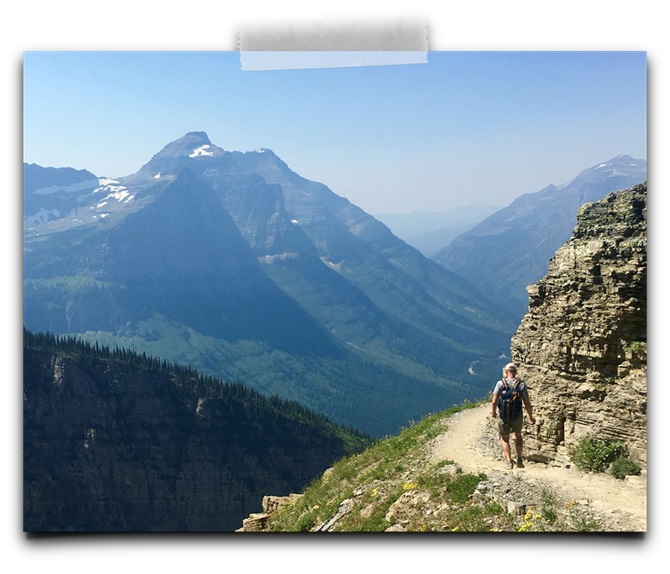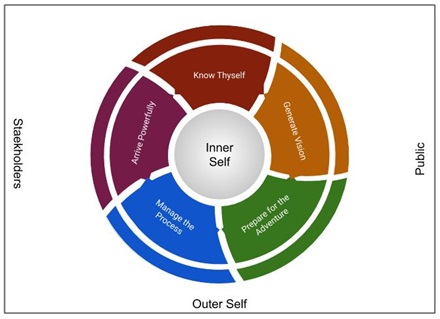A Coaching Model Created by David Kincaid
(Leadership Coach, UNITED STATES)

Being a visionary leader…

By definition, a leader is not just an individual but is rather a focal point of influence. This loose definition is inclusive of those who are commonly referred to as thought leaders as well as those leading organizations of all kinds. Organizations may include private companies, government or non-government entities, non-profits, philanthropic organizations, associations, c from ooperatives, or community-based organizations. Wherever others may be influenced, there is a leader. But, what makes a leader visionary? What does it mean to BE a visionary leader? A perusal of career development platforms Indeed and The Career Balance; scholarly papers and articles Michigan State’s Business School; the Leadership and Organization Development Journal (M. Taylor, C., J. Cornelius, C. and Colvin, K., 2014); as well as the business journal Forbes, yields a quick list of words that provide a signpost to nature—the BEING—of visionary leadership.
Some of these are:

Visionary leaders are looking to move beyond what IS to something or to somewhere new. They are Explorers, seeking to transform those they lead and empower them to embark on new missions into new territory. This is where inspiration and fulfillment lie.
Making a difference…
In today’s world, it is no longer sufficient to be a visionary leader. The world today wants to see those visionary leaders be the driving force behind organizations that are making a difference. Whether that be in small local communities helping to improve professionalism among the underserved or in large scale sustainable eco-tourism projects focused on connecting tourism, environmental protection, and stronger cultural communities, people are hungry for visionary leaders and organizations that contribute. Visionary leaders may lead their organizations to explore new product lines or to enter new markets or achieve new and extraordinary levels of mission success. They do so to improve the lives of others and make the world a better place.
How Can I Help?
Too often I have seen organizations flounder find their voice. They seem to have lost (or never had) a clarity that authentically reflects the vision and values of the organization. Such organizations are characterized by consistently fatigued staff, high levels of burnout, low morale, and an inability to achieve satisfying results. This is especially true among those organizations that have a passion and desire to do high impact work. Too quickly, organizations of this kind become lost in the “doing of good,” that they stop doing very much good. They become inefficient, cumbersome, and wander off mission.

Some have embraced the possibility of a new direction, a new product line, a new horizon towards which to expand. The excitement and passion that goes with such creative urges sometimes falls flat in implementation. Executives struggle to pry themselves free of the everyday demands of their jobs and have little time to focus on what’s most important; leaving the organization to be caught in a demoralizing struggle to stay alive.
I help organizations bring clarity to their vision and develop a strategic plan, firmly rooted in core values, talents, assets, and passions that will serve to align the organization more effectively with that vision. I support visionary leaders, and the organizations they lead, experience a shift in their way of operating that harnesses the power and energy of their talents to take on sustainable practices that will leave the organization taking big leaps into exciting new domains with strength and confidence.
What Enables Me to Do That?
First and foremost I am an Explorer. I have transformed my life from overweight to fit, from inactive to climbing mountains, and from homelessness to a Diplomat for the United States to Indonesia. On my most adventure, I completed the 500 mile Camino de Santiago pilgrimage across Spain, during a year of travel in which I hiked over 1500 miles across four continents!
Early in my journey, I experienced a profound shift in ownership of self and recognized that to overcome the challenges that had landed me on the streets, I would need to generate a new solution. I had no idea that when I walked into a Boys and Girls Club that day to ask for food money in exchange for work, that I was embarking on a new journey that would change my life. Since that time it has taken vision, rigorous self-inquiry, and an unwavering belief that anything is possible to overcome the challenges I faced along the way. Today, I continue to be an intrepid Explorer and I combine the lessons of my journey with years of working with companies, governments, organizations, and communities to focus on empowering others.
The Explorer Model
Our Coach-Client engagement will be guided by The Explorer Model. There are five elements in The Explorer Model: Know Thyself, Generate Vision, Prepare for the Adventure, Manage the Process, and Arrive Powerfully. I will cover each of these separately below. The Explorer Model serves as a way of organizing our work together but is not necessarily linear. As we move together through the five elements, a need may arise to return to previous elements to remain flexible and adaptive to new information and changing contexts. The Explorer Model is also not time driven. At times it may seem that work is stalled in one element only to experience a breakthrough that brings tremendous clarity and speed to the work ahead.
As we explore the five elements of The Explorer Model, there will be times of inward exploration, as well as outward. Taking the time to look inward—to look deeply within ourselves and within the organizations of which we are a part—is an invaluable part of The Explorer’s journey. George Lucas’ Star Wars mystics, the Jedi, often sat quite still before acting with lightning speed! The Buddha, a Jedi-like character, was known to sit at length in meditation before taking a decisive course of action. By doing so, we can promote effective action and avoid the exhausting and unhealthy freneticism in which many organizations find themselves trapped.
Finally, The Explorer Model supports the development of organizational capabilities whose benefits will extend beyond the coaching experience. As with individuals, so, too, it is with companies. To strengthen a muscle, one must use it. The Explorer Model is not just about the next benchmark; it is about leading change in the world.
Element 1—Know Thyself:
Within the first element, we will explore what is going on NOW. This may include the use of workplace performance assessment tools; interviews; key performance indicators (KPI’s); and group discussions to identify the context and content at the present. What is going on? It is paramount for an explorer—a visionary leader—to have a strong sense of self. From this foundational work, the creative exploration of vision and the implementation of that vision will then flow. Through a process of self-inquiry—whether that be the executive as an individual or for the organization writ large—limiting beliefs, underlying assumptions and other barriers to success begin to surface. This may seem daunting at first, but this is an exciting time in which to illuminate dark corners and prepare the individuals and the organization for the journey ahead.
Element 2—Generate Vision:
Our work in the second element of The Explorer Model is about defining and communicating a vision. Through inquiry, leaders ground themselves and their organizations in purpose and connect with the driving force of the organization. The client explores:
Clients will develop a strategy for communicating a vision. This may include the use of feedback and other fora to create stakeholder acceptance. Having a well defined and communicated vision supports the development of strategies to align stakeholder and organizational activities with that vision.
Element 3—Prepare for the Adventure:
As any good Explorer knows, preparation for the journey ahead is key. This is the focus of the third element of The Explorer Model. Coach and Client will explore what is needed, using a holistic approach, and develop a strategy to move towards the vision. An Explorer must consider a range of needs including health and fitness; knowledge; equipment and supplies; skills; networks, and support. So, too, must visionary leaders and the organizations they lead. Prepare for the Adventure builds on the assessment work done during the Know Thyself phase and connects with the Client’s vision.
Element 4—Manage the Process:
Element 4 is all about implementation but is far more than executing a task. Putting a strategy into action often means taking a leap that has only seemed theoretical before. Embarking on the journey is often accompanied by doubts, realizations about what does or does not work, and difficult lessons about endurance and sustainability. It is like The Explorer to reach beyond the box; expand into unfamiliar domains. There is no perfect way. As a result, visionary leaders must become adept at dealing with surprises, failed attempts, and disappointments. Such experiences drive The Explorer’s transformation. During the 4th Element, Coach and Client will seek to create awareness, build strength and agility; and bring balance to the lives of individuals and the organization.
Element 5—Arrive Powerfully:
Arriving at one’s destination may be more challenging than one might think! Many Explorers report feeling of apprehension just before achieving success. So much focus has been on the journey that a sense of disappointment may arise knowing the journey will end. Others experience low points or feelings of being lost shortly after achieving a big goal. Those that do not, however, are rooted in a sense of higher purpose—one that prevails beyond the immediate outcome. Arrive Powerfully is about receiving the fruits of the journey—acknowledging the achievement; recognizing stakeholders; celebrating; and experiencing the energizing sense of balance that has been a part of the journey. It is also about embracing the letdown, drawing upon new awareness; and connecting with a sense of purpose beyond the moment.
What are some ways that we can work together?
Customization is key. Depending on the need of the visionary leader and the organization, several modalities can be employed. Although consulting may be utilized as a tool when appropriate, the focus of this model is on coaching. As such, the following are ways that the Coach and Client can optimize their engagement:
What Can Be Expected From This Work?
An Explorer aligned with his or her vision is one who embarks upon the journey with cautious optimism knowing that he or she has the tools, skills, and knowledge to be successful. Such Explorers embody a deep sense of self and remain adaptive to changing conditions on the road ahead. When Leaders align their organizations with Vision and foster an enduring balance among members, together they achieve new levels of creativity, innovation, and personal fulfillment. Executives and Organizations can then live into their visions with ease.
References
14 traits of visionary leaders. (n.d.). Job Search | Indeed. https://www.indeed.com/career-advice/career-development/traits-of-visionary-leadership
- Taylor, C., J. Cornelius, C., & Colvin, K. (2014). Visionary leadership and its relationship to organizational effectiveness. Leadership & Organization Development Journal, 35(6), 566-583. https://doi.org/10.1108/lodj-10-2012-0130
Petrucci, A. (2019, June 6). Council post: Visionary leadership: Five insights to shape an emerging industry. Forbes. https://www.forbes.com/sites/forbescommunicationscouncil/2019/06/06/visionary-leadership-five-insights-to-shape-an-emerging-industry/#7b8df7306ee4
Visionary leadership has 3 characteristics you want to find and follow. (2018, August 28). Balance Careers. https://www.thebalancecareers.com/visionary-leadership-4174279
What are the qualities of a visionary leader? (2020, February 5). Michigan State University. https://www.michiganstateuniversityonline.com/resources/leadership/qualities-of-a-visionary-leader/
What is visionary leadership? 7 traits of a visionary leader. (2020, April 11). Status Articles. https://status.net/articles/visionary-leadership/